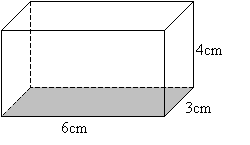What is density?
The amount of matter in a given space or volume.
What is buoyancy?
The ability of an object to float.
What is the density of water?
1 g/mL
Why is it important to prototype during the engineering process?
So flaws can be assessed and remedied.
How can you measure the volume of an object using water?
The amount of water displaced is equal to the volume of the object.
What is the formula for density?
Density = Mass / Volume
Explain this image:
The object is floating because the buoyant force is equal to the force of gravity, ergo no net force is acting on this object, so it is floating.
What is fluidity? What types of matter exhibit fluidity?
The ability of molecules of a substance to move around one another. Gases and liquids exhibit this.
Why is it important to blueprint prior to building or prototyping?
To ensure that all dimensions of what you are building are already decided on and it can be accurately built.
According to Archimedes' principle, why would an object sink?
The mass of the object is greater than the mass of the water it displaces.
If you have an object with a mass of 55 grams and a volume of 15 mL, what will be its density?
3.67 g/mL
In water, how can you tell what percentage of an object is under water?
It is equal to the density times 100.
What is viscosity? How does viscosity affect the ability of an object to move through it?
Viscosity is the measure of a liquid's fluidity. The more viscous a liquid, the slower an object moves through it.

If the above rectangle has a mass of 65 grams, what will be its density?
Will it float on water?
0.90 g/cm3
Yes, it will float.
What does Archimedes' principle state about floating objects?
The mass of a floating object is equal to the mass of the water it displaces.
Harrison has a rectangular prism with measurements of .30 cm by .25 cm by .6 cm. If the object's density is 1.5 g/cm3, what is its mass?
Volume = 0.045 cm3
Mass = .0675 g
What percentage of a piece of styrofoam will be above the surface of water is it has a mass of 11 grams and measures 5cm by 1cm by 2.5cm?
12%
What is surface tension? How does it work?
Surface tension is the extra force of attraction between surface molecules in water. Water molecules have cohesive forces between them; at the surface, they have no molecules above them, ergo they are extra attracted to the molecules around them. This causes surface tension.


What is the volume of this cylinder?
62.8 cm3
What purpose did the outside material (bottles, styrofoam, bubble wrap) serve on your boat?
Increase the buoyancy of the boat and allow it to sit higher in the water.
Giselle has this cylinder and needs to figure out its density:

If the mass of the cylinder is 3100g, what is the density? Will this cylinder float?
The density will be 1.03 g/cm3 and it will not float.
What is neutral buoyancy?
When an object's density is equal to the density of the liquid it is in.
What is the mass of 500 mL of water?
500 grams

If the above cylinder has a mass of 1050g, what is its density? Will it float?
Volume = 942 cm3
Density = 1.11 g/cm3
It will not float.
How do boats work?
They spread mass over a larger area, displacing a greater amount of water, allowing them to float.